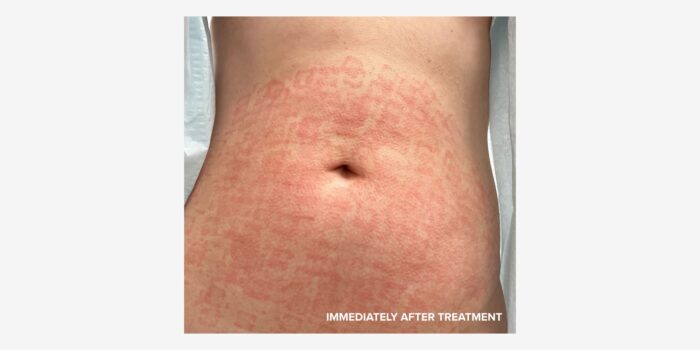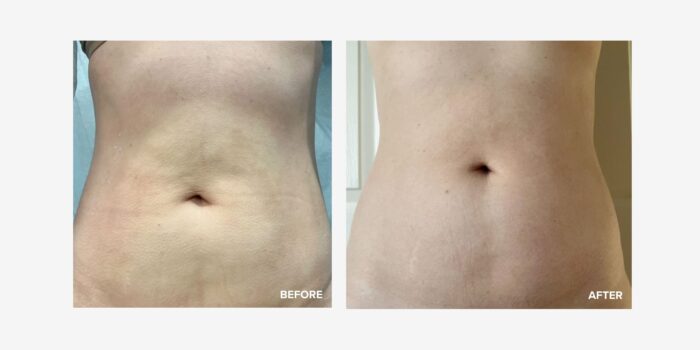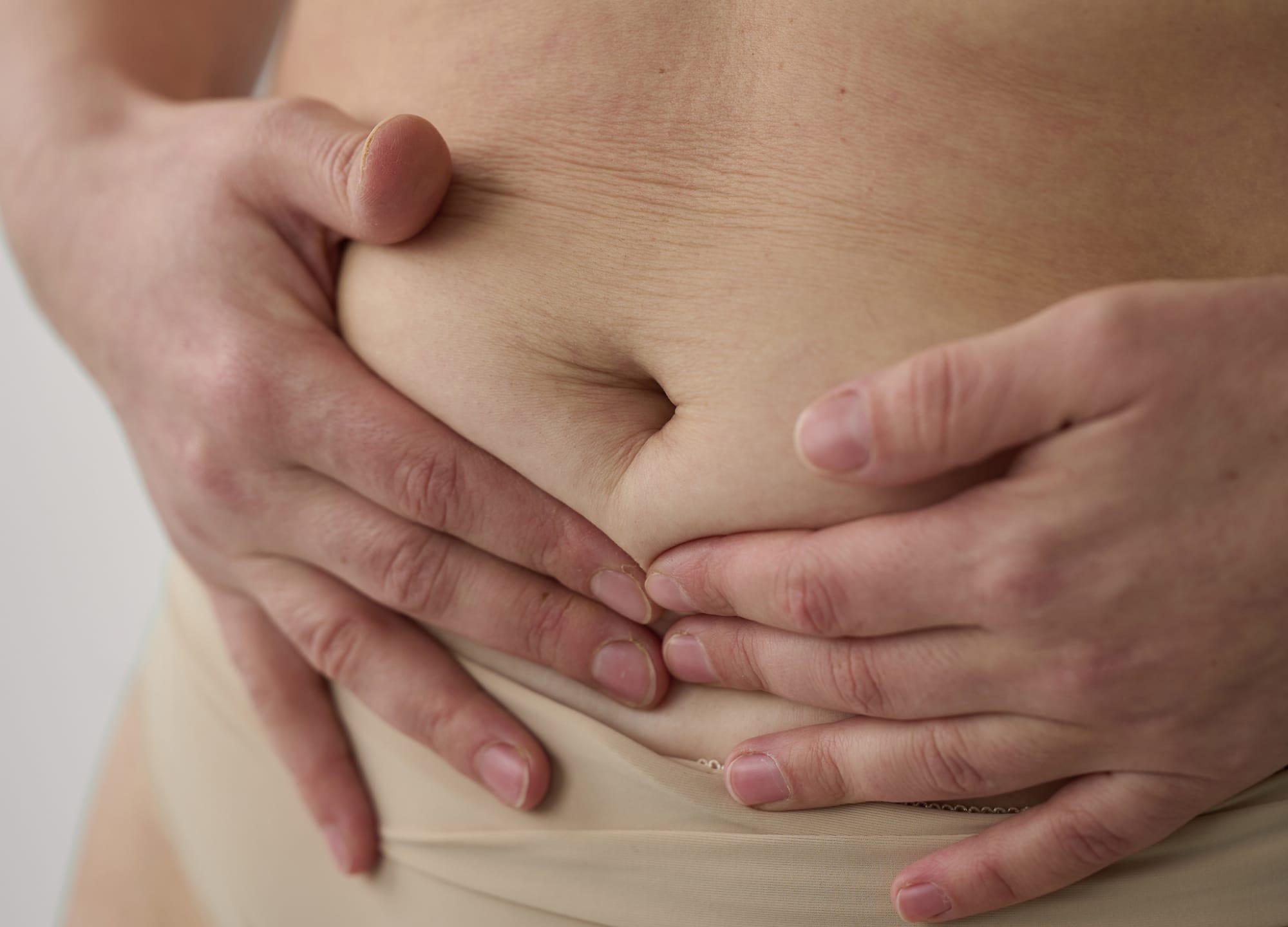The treatment I tried
Morpheus8, on my stomach
My provider
Dr. Michelle Henry, a board-certified dermatologist in New York City
What is Morpheus8?
Morpheus8 is a combination treatment that pairs microneedling with radiofrequency. “Radiofrequency is energy that’s converted to heat once it hits its intended target. That heat is what helps stimulate collagen, tighten the skin, and reduce laxity,” explains Dr. Henry. Other benefits include smoothing skin texture and addressing scarring as well as minimizing the look of prominent pores. Also nice: it can be used almost anywhere on the face and body, simply by adjusting the needle size and energy based on the area you’re treating, notes Dr. Henry, who adds that the face, neck, and stomach are the most common spots she treats.
How is Morpheus8 different from other types of RF microneedling?
Morpheus8 needles can penetrate up to seven millimeters into the skin when used on the body, and the RF energy can go another millimeter. This is deeper than other RF microneedling treatments on the market. On the body, there is also something called “burst mode,” which deploys the energy at multiple depths within milliseconds, allowing for faster treatment time and more uniform deployment of energy. On the face, needles penetrate four millimeters, which is the same depth as other devices.
Who is a good candidate for Morpheus8?
“This isn’t for someone who needs a facelift, as it’s not going to lift inches of loose skin,” notes Dr. Henry. “It’s best for someone with mild to moderate laxity and who is willing to be consistent and do more than one treatment in order to get the best results.” Unlike certain lasers, however, this is safe for all skin tones; the RF energy doesn’t fire until it’s deep in the skin and doesn’t target melanin, she says. (That being said, higher settings where there is more heat in the skin can potentially increase the risk of burns and postinflammatory hyperpigmentation in Fitzpatrick IV and above skin types, which is why the settings are adjustable. More on this point in a moment.)
Why I tried Morpheus8
After my pregnancy, I was left with some skin laxity on my stomach that seemed to get more pronounced as I lost the weight in my midsection. In particular, I noticed that my belly button had sort of fallen, creating a squishy, sad face line; when I bent over, the skin above it would be extra crinkly. I also noticed that my lower belly looked dimpled, like the skin wasn’t draping over my lower abs as tightly as it used to. Although I’ve always had some fat in my stomach—and still do—I never noticed an issue with the skin until after I had my baby.
After researching a number of RF microneedling treatments, I decided on this one because the body handpiece penetrates seven millimeters into the skin. The radiofrequency energy can penetrate another millimeter, for a total depth of eight millimeters (hence the name Morpheus8), deeper than any other devices. At the deeper levels, the RF energy can also melt fat, and I wasn’t going to say no to that. Basically, I was looking for the most aggressive noninvasive skin-tightening treatment out there.
What my Morpheus8 treatment was like
I saw Dr. Henry for a total of three treatments over the span of six months. I had read up on the treatment extensively, including all the RealSelf reviews, and watched what felt like every Morphues8 TikTok video out there. I was most concerned about the pain, as it seemed like Morpheus8 was notorious for being extremely painful. Dr. Henry assured me that it would feel pretty similar to many laser treatments, like a hot rubber band snap. Because I was getting the treatment on my stomach, I wasn’t as concerned about side effects as I would be if I were getting it on my face. But I did talk to her about some of the potential issues I’d read about online. Dr. Henry told me that it could cause hyperpigmentation when used at an incorrect setting for the individual’s skin tone but that it was her job to mitigate that. (I’m a Fitzpatrick IV and prone to postinflammatory hyperpigmentation.) For that reason, we decided to take a more conservative approach and go with slightly lower settings; higher settings can be more effective, but they also come with an increased risk of burns and marks.
I had also read that some people complained of slow healing and residual track marks from the needles. Dr. Henry said that while some patients may experience crusting and peeling, they usually resolve in a week or so, although sometimes skin can react in a way that is not predictable even for the most experienced provider. Since I was getting my stomach treated in the middle of the winter, this wasn’t something I was worried about.
At our first visit, she evaluated my stomach and we discussed goals and especially noticeable problem areas that I wanted to treat. She noted that since I had more fat in the lower part of my abdomen, she would go deeper in that area, to try to treat both that and the skin laxity. She then applied a topical numbing cream for about 40 minutes. Both she and other providers offer different levels of pain management, including topical and injectable anesthetic as well as laughing gas, but she felt that for my treatment settings, topical numbing would suffice. She started with a test spot, and I was pleasantly surprised at how tolerable the pain was. It definitely hurt, but I wasn’t deeply uncomfortable.
The treatment consisted of three passes, covering the upper and lower abs from flank to flank. The handpiece is placed against the skin, the needles go in to the intended depth, and the RF energy fires for a second. Then the handpiece is moved and the process begins again. Every time the needles penetrate and the energy fires, the machine makes a beeping sound that tells the provider that everything worked according to plan. If the placement isn’t quite right, the machine makes a different “error” sound that tells the provider to repeat it in that area. As a patient, I was a bit surprised at how loud the beeps were and it was a bit disconcerting at first to hear the error beeps, but I quickly realized that they were no big deal. The first pass is done at the deepest level (six to seven millimeters, as determined by your provider); the second pass is done at a medium depth, and the last pass is done at the most superficial level, two to three millimeters. This is so that the RF energy can target all the layers of skin, to elicit a collage response. I found the superficial last pass to be the most painful because the heat was closer to the skin, about a seven or eight out of 10, whereas the other passes were about a five or six. During the most painful parts, I didn’t want to carry on a conversation, but it was never so painful that I wanted to stop. And the longer I numbed beforehand, the less pain I felt. The actual treatment takes only about 10 minutes.
What my skin looked like immediately afterward

My skin was bright pink and hot, and I left with two ice packs tucked into my waistband. About an hour after the treatment, my skin had calmed down significantly and I had no other side effects or discomfort. I think I was more cautious about keeping the area cool after the first treatment, but after the second and third rounds, the redness seemed to go down much quicker. I didn’t feel any chafing or pain from my pants rubbing on the skin. The evening of the treatments, all the redness and any swelling had basically subsided and the only telltale sign was the microneedling marks. Those marks lasted for about two weeks, during which the skin texture also felt rough. Dr. Henry recommended using a healing gel, such as Alastin Skin Nectar, to help speed up the healing process. The only other side effect I had was random spots of itchiness, which pop up about a week after the treatment and can linger for a while. But all the side effects were gone after about a month.
My Morpehus8 results

It took a while to see results, but when I look at the side-by-side pictures now, it’s obvious everything looks better. In my before picture, I can see a circle of crepey skin in the shape of how my belly expanded during pregnancy and that’s gone in the after photo. During my research phase, I saw all of these amazing before-and-afters that were taken four or five days after just one round; that wasn’t my experience. I also question those results because it takes time for collagen to form, but they had definitely swayed me into thinking this was the treatment I needed. Dr. Henry told me that around my third treatment is when I would start seeing results from the first treatment, and that was true. I don’t think I saw any results until about two or three months after the first appointment. By that time, I’d already had my second treatment, and then about a month after that, I noticed that my skin looked smoother and tighter. I would love to have even more tightening, but I love the improvement I’ve already seen. Most obviously, my belly button is more lifted and the skin surrounding it is smoother. It’s now been about a month since my last treatment and I don’t think I’ll see the absolute final results for another three months.
How much Morpheus8 costs
According to RealSelf members, the average cost for one treatment is $1,875, though it can range from $500 to $3,900. This is dependent upon your provider, their geographic location, and the area being treated.
Final verdict
The science behind Morpheus8 is robust, but results depend on how many treatments you get and what settings your provider chooses. Keep your expectations realistic and don’t expect to see a change overnight. But give it some time and suddenly, one day, you’ll probably notice all the improvements happening at once, just like I did.











